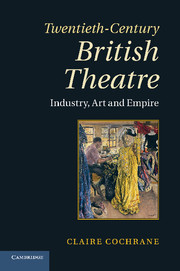Book contents
- Frontmatter
- Contents
- Acknowledgements
- Introduction
- Chapter 1 The topography of theatre in 1900
- Chapter 2 Structures of management
- Chapter 3 The profession of acting
- Chapter 4 The amateur phenomenon
- Chapter 5 The topography of theatre in 1950
- Chapter 6 The business of theatre
- Chapter 7 The changing demographic of performance
- Chapter 8 The topography of theatre in 2000
- Conclusion
- Notes
- Select Bibliography
- Index
Chapter 2 - Structures of management
Published online by Cambridge University Press: 05 November 2011
- Frontmatter
- Contents
- Acknowledgements
- Introduction
- Chapter 1 The topography of theatre in 1900
- Chapter 2 Structures of management
- Chapter 3 The profession of acting
- Chapter 4 The amateur phenomenon
- Chapter 5 The topography of theatre in 1950
- Chapter 6 The business of theatre
- Chapter 7 The changing demographic of performance
- Chapter 8 The topography of theatre in 2000
- Conclusion
- Notes
- Select Bibliography
- Index
Summary
Theatre at the beginning of the twentieth century flourished within a market economy predicated on a belief in the moral virtues of free enterprise and individuation. Theatre, especially building-based theatre, requires capital investment and sufficient working revenue in order to survive. If the primary function of theatre practitioners is to create and market a product of sufficient quality and/or popular appeal to make it financially self-sufficient, then clearly the law of the survival of the fittest seems entirely rational. The historian of the comparatively obscure Alexandra Theatre, opened in Birmingham in 1901 and run as an independent family business until 1968, dubbed the commercial imperative which shaped employees’ lives the ‘if-it’ principle: ‘what didn’t come in to the box-office couldn’t go out in the players’ pockets’. The overwhelming majority of professional theatre ventures operated on that basis until well into the 1950s.
If, however, a theatre is envisaged as a concrete embodiment of the cultural prestige of a nation which is expressed in terms of intellectual and artistic excellence and innovation, or if it functions as an exemplary instrument of social betterment and change, then achieving and maintaining a secure resource base, certainly in the prevailing political and economic climate of the early twentieth century, required a seismic shift in the national mentalité. Harley Granville Barker, who published The Exemplary Theatre in 1922 when he had pretty much given up active theatre practice, described his ideal theatre in evangelical terms. It would be like a chapel:
this new meeting house … with its doctrines worked out in a human medium, its range from past to future, its analysis in method and synthesis in effect … will be, by virtue of the unity in diversity for which it might strive, a microcosm, not only of the social world as it moves, laughs, weeps before our eyes, but as it has a sublimer being in the souls of men …
This passionate language, from a man who had earned his living in theatre since the age of fourteen, published with the critic William Archer a realistic costing of all the practical components of a national theatre project, and formed business partnerships with leading entrepreneurs such as J. E. Vedrenne and Charles Frohman in order to establish his ideal theatre, was not untypical. For those who worked for a theatre that prioritised art over commerce and were convinced that an intelligent, challenging dialogue with audiences could effect social change, the campaign was akin to a crusade.
- Type
- Chapter
- Information
- Twentieth-Century British TheatreIndustry, Art and Empire, pp. 46 - 77Publisher: Cambridge University PressPrint publication year: 2011



